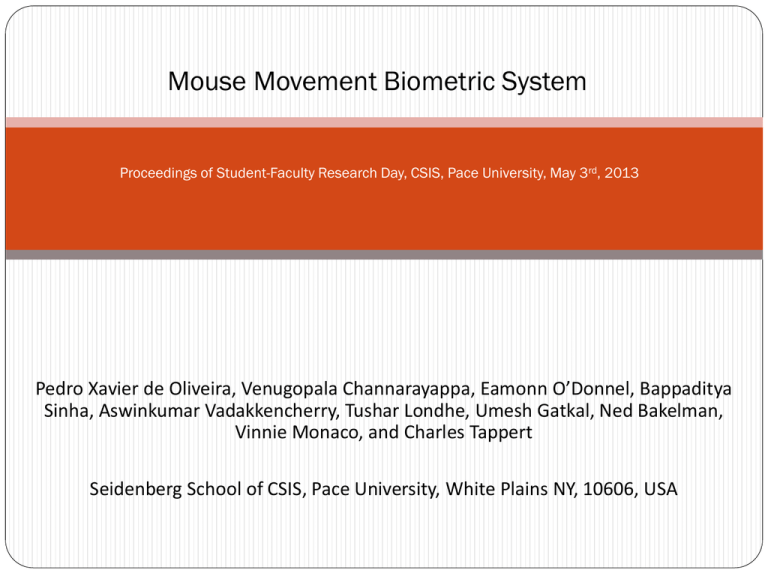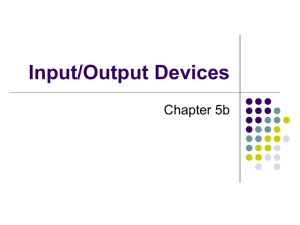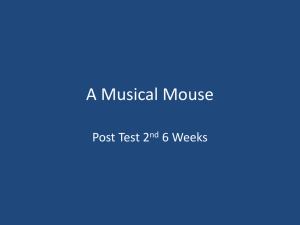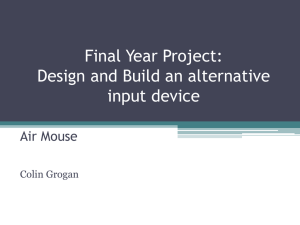slides - Seidenberg School of Computer Science and Information
advertisement

Mouse Movement Biometric System Proceedings of Student-Faculty Research Day, CSIS, Pace University, May 3rd, 2013 Pedro Xavier de Oliveira, Venugopala Channarayappa, Eamonn O’Donnel, Bappaditya Sinha, Aswinkumar Vadakkencherry, Tushar Londhe, Umesh Gatkal, Ned Bakelman, Vinnie Monaco, and Charles Tappert Seidenberg School of CSIS, Pace University, White Plains NY, 10606, USA Introduction •User authentication Password Token Fingerprint •Behavioral Biometric systems Provide data specific to every user’s characteristics •The mouse biometric system Continuous dynamic authentication No additional hardware requirement 2 Related work • Different approaches available to collect data Using pre-defined grid systems User specific gaming scenarios Capture data using specific applications • No detailed work around capturing natural mouse movements. 3 Current Research Approach • Mouse Movement Biometric System 4 Generic Mouse Movement Data Capture. User accessing a computer for a specific time duration. Any natural mouse movement event captured. Unpredictable behavior but completely user behavioral. Feature extractor to capture / convert all mouse events. Stronger continuous user authentication not restricted to login time. Features Measurements • Researched and identified mouse movement categories and features • Mouse Movement Categories • Mouse Trajectory • • • • 5 System wake up Move and click Highlight Drag and drop Mouse Click Mouse wheel spin or scroll Applications accessed Mouse activity time Trajectories features • Number of trajectory points • Time of the trajectory • Point-to-point distance in the trajectory • Length of the trajectory • Point-to-point velocity in the trajectory • Point-to-point acceleration in the trajectory • Point-to-point direction angle change • Number of inflection points in the trajectory • Curviness of the trajectory mean (average), median, minimum, maximum, standard deviation 45 features for each action type, totaling 135 features 6 Trajectories features..(contd) • Trajectory ratio features number of wake - up actions total number of trajectory actions number of move - and - click actions total number of trajectory actions number of highlight and drag - and - drop actions total number of trajectory actions 7 Mouse Click features • Type of mouse click 8 Left click Right click Double click Highlight Drag-and-drop • Ratio of clicks (4 features) • Average of clicks (5 features) Mean, Median, Minimum, Maximum dwell from left/right clicks (12 features) Mean, Median, Minimum, Maximum transaction time of all double click/drag-and-drop (8 features) Total of 29 mouse click features Mouse Wheel Spin features • Mouse wheel event Scroll up Scroll Down • Ratio of scroll up/down to total of mouse wheel events • Ratio of time spent in wheel event Mean, Median, Minimum, Maximum duration of a mouse wheel event (12 features) Mean, Median, Minimum, Maximum distance for a mouse wheel event (12 features) Mean, Median, Minimum, Maximum speed of a mouse wheel event (12 features) Total of 39 mouse wheel features 9 Applications features • • • • 10 The number of applications accessed The name of the most used (in time spent) application The name of the second most used application The name of the third most used application Mouse Activity Time • The Fraction of session time involving mouse activity • Fraction of mouse activity time used for wheel spin event • Fraction of scroll activity time used during mouse selection (shift key + mouse move event) • Fraction of mouse activity time used for mouse move events • Fraction of activity time used in scroll up event • Fraction of activity time used in scroll down event 11 Features List Summary • Total of 217 features 138 trajectory 29 mouse click 40 mouse wheel spin 4 application accessed 6 mouse activity time 12 Mouse biometric system 13 Feature extraction system • Use data collected by the Online Biologger (http://vmonaco.com/biometrics/logger) • Convert CSV to generic XML mouse data • Feature extractor Categorize / extract based on mouse events. Generate a CSV file with data generated Option of parsing multiple user session input XMLs. 14 Authentication Classification Transform a multi-class problem to a two-class problem Effective in large open biometric systems like mouse movement. Authentication comparison of various user samples versus the trained previous samples Calculate / Derive the differences of vectors Authentication result based on pre-calculated False Accept Rate (FAR) and False Reject Rate (FRR) 15 You are authenticated You are not authenticated Ideally no two user sample can have a 100% match! System Test 16 Continuous authentication based on detection of user change over time. Different tasks needs to analyzed / extracted to test the generic user behavioral mouse biometric system. Three different scenario sets are identified Edit / Modify tasks Browser tasks Gaming scenarios Edit / Modify Tasks 17 Edit or Modify tasks include writing new document (typing), modify or rewrite content. Light copy editing Minor-Minor editing Moderate copy editing Heavy copy editing Major changes and document rewrite Browser Tasks 18 Generic scenario exercised by every computer user. Heavy mouse movement / usage. User differentiated by the way of browsing (internet content) behavior. The behaviors include mouse actions mouse clicks, mouse pause (reading content), scroll, right click etc. User Behavior can be tracked for various actions – open/close browser, open/close regular websites, search etc. Gaming Scenarios 19 Strong contender for all aged user data capture. User differentiated by the mouse activities performed during the game play. The behaviors include mouse actions - mouse clicks, mouse pause (reading rules), scroll, right click etc. Gaming scenarios focus on the performance of the system in authenticating the game player when all participants play the same game. Conclusion • Primary focus of this research was to identify various mouse biometric features • 217 feature sets identified! • Developed a java feature extractor system. • Capture / extract generic mouse movements • Future work • Future groups can further investigate / improve the quality of the software by using more classification results with larger amount of data. 20 Thank You! 21






